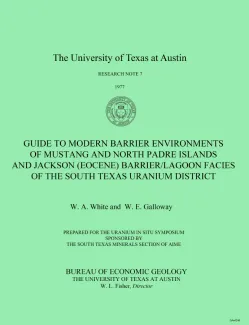Publication Details
Geolocation:
Get the Publication
Abstract/Description:
Combining process and geomorphic description (supplied by studies of modern depositional systems) with the three-dimensional description of sedimentary units and their internal structures (accomplished in the stratigraphic record) produces an integrated facies model that can be applied to the interpretation of similar facies in other systems.
Part I of this report briefly reviews modern depositional environments in the Corpus Christi area, followed by a more detailed look at modern barrier environments on Mustang and north Padre Islands (via a map of land and water resources, and a field trip). Emphasis is placed on active processes, and on physical, chemical, and biological characteristics as they are reflected through surface and near-surface conditions.
Part II describes the geometry, internal features, and sedimentary structures of uranium-producing barrier island and associated coastal plain facies of the Jackson (Eocene) barrier system. The similarity between the Eocene and the Quaternary South Texas Coastal Plain depositional systems provides the basis of detailed facies interpretation and paleoenvironmental reconstruction. This interpretation and reconstruction is, in turn, the basis for understanding the nature and the distribution of uranium mineralization.
